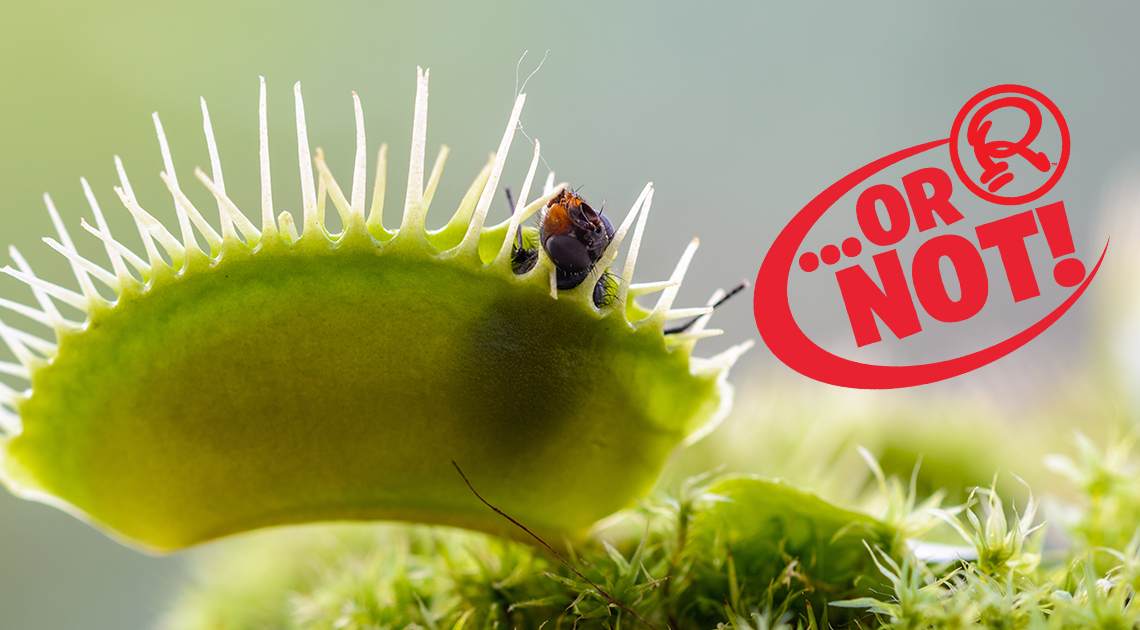The 1986 movie Little Shop of Horrors features a geeky florist shop worker who discovers his Venus flytrap, Audrey II, can talk. Before the end of the movie, the plant’s made a play for world domination devouring anybody it can get its jaws on along the way. The portrayal of a man-eating Venus flytrap is about as incredible as it gets. Yet, the core of the plot relies on the commonly held belief that this carnivorous plant is entirely opportunistic…
Devouring any creepy crawly unfortunate enough to cross its path.
Of course, there’s one major problem with this. How do Venus flytraps get pollinated if they devour all the insects that draw near them? Keep reading as we debunk the myth of the Venus flytrap’s insatiable hunger. Along the way, we’ll explore how the flytrap’s structure makes it a nectar-rich haven for some and a death trap for others.
“Feed Me, Seymour!”
Venus flytraps (Dionaea muscipula) have fascinated humans for hundreds of years. How many other plants boast a movie with a cult following? Despite centuries of study, we still have much to learn about their molecular underpinnings, though. We know they’re native to a tiny ecosystem covering a 100-mile radius near Wilmington, North Carolina. We also know that as a vulnerable species, conservation efforts must be rooted in a thorough understanding of the plant’s anatomy and reproductive system.
Scientific discoveries in the past few years are shedding new light on these fascinating and complex plants. Computer simulations and biomechanical analyses of their snapping mechanisms have provided data about their lightning reflexes. It takes a mere 100 milliseconds for the leaves of the trap to snap shut after an insect stimulates a trigger hair!

Researchers have also learned that these flesh-eating florae grow snap traps of different sizes. Why? To capture insects of varying scale. After all, there’s a significant size gap between a housefly or large ant and a mosquito. Yet, both offer essential nutrients. The solution? Trap-size-based sensitivity.
According to Rainer Hedrich of the University of Würzberg, “This trap-size-based sensitivity of the trigger hairs is crucial for the economic efficiency of the traps.” In essence, big insects trigger big traps. The nutrients from larger prey offset the energy lost when large snap traps close and reopen. As for little traps? They spring at a lighter touch, like that of a mosquito. Smaller meals mean fewer nutrients. But that’s okay because small traps don’t require nearly as much energy to close and open. Without this trap-size-based sensitivity, flytraps would expend too much energy on prey of insufficient size, essentially starving.
Venus Flytraps and the Bugs that Pollinate Them
But what about the insects that pollinate flytraps? Researchers at North Carolina State University spent months slogging through the woods, checking flytrap flowers as well as the putrid content of snap trap pouches. Their results provide a surprising glimpse into flytrap biology and reproduction.
Of the 100 types of insects found on Venus flytrap flowers, only a handful carried significant amounts of the plant’s pollen. The three most significant pollinators were:
- The green sweat bee (Augochlorella gratiosa)
- The notch-tipped flower longhorn beetle (Typocerus sinuatus)
- The checkered beetle (Trichodes apivorus)
Next, researchers explored how many of these flytrap pollinators fell prey to the plants. They studied the contents of more than 200 flytraps; the results were astonishing. Despite the regularity with which the three primary pollinators visited flytrap flowers, they never ended up in the traps. How did the bees and beetles in question avoid the gory fate of non-pollinators?
The Deceptive Architecture of Venus Flytraps
While more research is needed to unlock the secrets of the Venus flytrap, scientists have a few theories. Elsa Youngsteadt, lead author and research associate at North Carolina State University, theorizes the plant’s architecture may hold a critical key. The placement of the flowers on flytraps is vital. They sit elevated on stems high above the snap traps of the plant. Since the plant’s primary pollinators fly, they remain free and clear of trouble.
As for prey? Youngsteadt notes, “Only 20 percent of the prey could fly. The pollinator species may simply be staying above the danger zone as they go from flower to flower, making them less likely to be eaten.”
Researchers speculate other biological factors may also be at work. For starters, the plant’s snap traps are a different color than its flowers. Do these color variations lure different insect species to specific areas of the plant? Only more time and research will tell. Some scientists even speculate the traps may release different chemical agents than the flowers, resulting in a dangerous siren call for the plant’s favorite prey.
Scientists plan on investigating more Venus flytrap sites to see if the data collected about these three primary pollinators holds up in other locations. They also wish to explore additional questions about flytrap biology, such as how much pollen is necessary for reproduction, what type of nectar the plant produces, and the role fire events play in reproductive success. According to Rebecca Irwin, study co-author from NC State, “There is still a lot to learn about these plants and their pollinators.”
Fortunately, none of them have started talking!
By Engrid Barnett, contributor for Ripleys.com










Comment Your Reaction